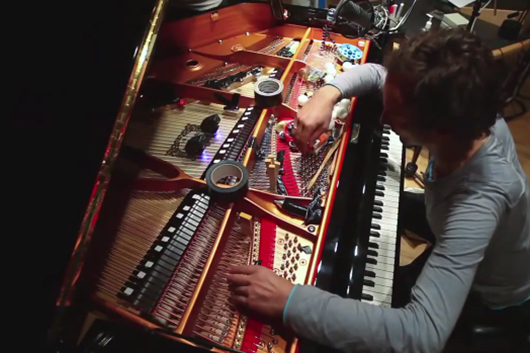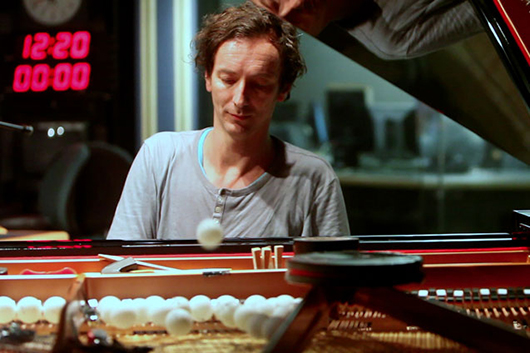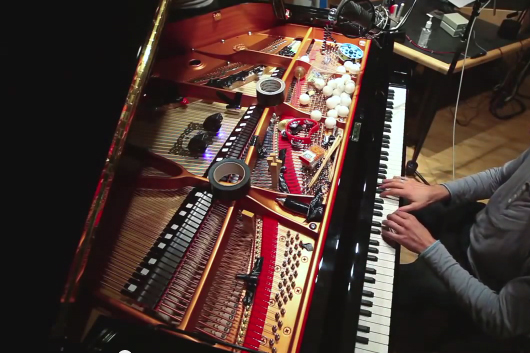Artist Tips – Hauschka Shares the Secrets of the Prepared Piano
Last week, German composer and pianist Hauschka (a.k.a. Volker Bertelmann) released his latest LP, ‘Abandoned […]

Last week, German composer and pianist Hauschka (a.k.a. Volker Bertelmann) released his latest LP, ‘Abandoned City.’ (For those who haven’t heard it, the album is still streaming online.) A concept album that finds Hauschka employing improvisational techniques while creating music to accompany an imaginary journey through ruined urban landscapes, ‘Abandoned City’ also showcases Bertelmann’s skill with the prepared piano. While many pianists prefer to focus on classic sounds, Hauschka takes things further, altering the instrument by placing objects on or between the strings, hammers, and dampers. Though the benefits of his methods—and the expanded musical possibilities they facilitate—are likely apparent to just about anyone who’s heard his output, we still figured that Bertelmann could pass along some further insights. He obliged by detailing a few of his methods, but also took the time to explain the conceptual appeal of the prepared piano, and even shared some tips for properly amplifying the instrument.
Prepared pianos
Somehow, it seems to me strange that once a machine or an instrument is built, only a very few people try to find out which possibilities are possible in all extremes.
I think preparing the piano is a decision for sound as well as an abstraction of the instrument itself. In essence, you can add layers that create the sound of an orchestra.
I personally started preparing the piano in order to create electronic music with an analog instrument instead of using electronics or a computer. The first sound I came up with was a hi-hat sound created by a Christmas cake bag that was given to me by a friend in a studio. I think that example demonstrates the principle of my work, but it also reflects the idea of how important it is to stay as creative as possible. I give randomness enough space in my work, but also give it a deeper sense by incorporating it into a broader concept.
John Cage mentioned the concept of randomness as a part of getting away from his own habits and increasing the chance of finding something new. I totally agree with that and in fact, it can be compared to the simple act of walking.
If you walk everyday to the same place—for example, maybe to your work—and you always take the same route, it gives you security and familiarity. You can find your way in your sleep even; but if you purposely change directions or take a different route every day, you will have different and maybe eye-opening experiences.
I like both methods, but you have to know when it’s time to change your habits.

Pianos are synthesizers
Of course this is not true, as pianos are analog instruments and synthesizers have oscillators as their sound source. But looking into the different types of preparations, the piano tone can be altered or added to. I also try to create sustainable notes through this process. Here is a basic rundown of the sounds I create:
Mutes
I use felt wedges and mutes that piano tuners are using to mute the overtones and to shorten the note in general. The other good way to mute the piano tones is to use, believe it or not, art erasers. They are very flexible and they stick to the strings without leaving any material on the strings themselves.
Some of the mutes can add an additional tone as well, especially when you use wooden material. I tape saxophone and clarinet reeds together and stick them between the two strings. That mostly creates a wonderfully full hi-hat sound.
Sustained sounds
The problem with a piano is that you can’t create steady carpets of sound that sustain as much as you want them to. You need to find a way to trigger the string constantly, but at the same time have them be quiet enough to have unwanted sounds added. For this, I use ebows that were built for electric guitar in the ’70s. They work perfectly on the piano. If you use them on the bass notes, you have to put two together, as long as the strings are thin enough that they can find space to resonate.
The lowest area on the piano can’t be triggered with the old ebows. The other method is using electric motors that are quiet, similar to small vibrators. You have to paste them at the end of the string with gaffer tape, so that they rattle on the string. You can then regulate the sustain with the sustain pedal.
Percussive sounds
I use a lot of paper and foil to create hi-frequency percussive sounds like clicks, hi-hats, or crackle sounds. They have to be arranged between the hammer and the string of a piano. A good material for this is a light filter.
For a more rattling sound, I use beer bottle caps, necklaces, or marbles. When these kinds of things are loose, they can create their own rhythms that are quite interesting.

Amplification
Another big theme for me is piano amplification. It is difficult to get the whole spectrum of frequency amplified enough to fill a whole stadium or a large venue. My first experience with that was when I played at Roskilde Festival in Denmark. I was in a tent in front of 3000 people, and I played with a string quartet and the pieces were very lyrical and dynamic and quiet.
At the same time, Gogol Bordello was performing on the big stage next to us and we had to incorporate their bass notes to actually make an acceptable performance. So we tried to transpose the pieces to the key in which Gorgol Bordello was playing. That’s an example of the kind of open concept that I appreciate, but on the other hand, it was after this show that I decided that I want to fill the space of a big concert hall or stadium with a pure piano sound, so that people can’t hear the sound from a competing stage next door.
We decided to use six mics on the piano, plus a Helpinstill pickup. This allowed us to boost the bass so much that it nearly sounded like a hip-hop bassline. Because I travel with my sound guy, he can always adjust the volume of bass and depending on the piece, it is great to have the very pure piano sound correctly balanced.

Which pianos can be prepared
You can do all of these things with an upright and a grand piano. The gravity works differently on each type though, as the preparations are hanging on an upright piano, while they’re lying on a grand piano.
The unprepared piano
One of the things that people might think is that I only love prepared pianos. However, I have to admit that the purity of the piano sound is one of the most beautiful things that I know.

